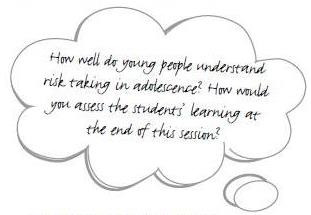You are in: Europe
Change location
You are here
Understanding Risk During Adolescence

The aim of risk education is to improve young people’s risk decision making so that they can act on their intentions to behave in safe and healthy ways through:
✓ Awareness of hazards
✓ Assessing the probability of both beneficial and harmful outcomes associated with a particular activity or behaviour
✓ Knowing and developing competence in measures to maximise benefits and minimise harm.

Lesson Idea
Invite students to suggest examples of risky behaviour for their age group. Write one on each of eight sheets of A4 in large lettering. Include driving a car as well as other examples they might not have included, such as sexting or being inactive (lack of exercise).
Ask students to choose one of the risk behaviours and to take a position on an imaginary line in the classroom between high risk and no risk.
They will need to compare their risks with others in the line to decide their final position. Now invite the students to say why they have chosen this position. Do the other students agree with the relative riskiness of the activities? Suggest that someone who disagrees with the position of a particular activity can take the same card. Do they choose to stand in the same or a different position? This activity illustrates the subjectivity of risk – what seems risky to one person may not seem so risky to another.
Give the student holding ‘driving’ a new sheet of paper ‘driving with passengers’. Ask the class to say whether they think this makes driving more or less risky. Explain that driving with passengers is more risky for young drivers than for older drivers, and that changes in the development of the brain may explain this.
Now ask the students in the line to reflect on what influenced their decision to stand in this position. Was their decision mainly influenced by what they know (head) or by how they feel (heart)? Ask each student to take one step forward for ‘head’ and one step backward for ‘heart’. Again, different people may have different responses to this for the same risky activity.
Now introduce the idea to the class that their brains develop rationally and emotionally at different rates and the effects this can have on everyday choices and decisions as they grow and mature.


